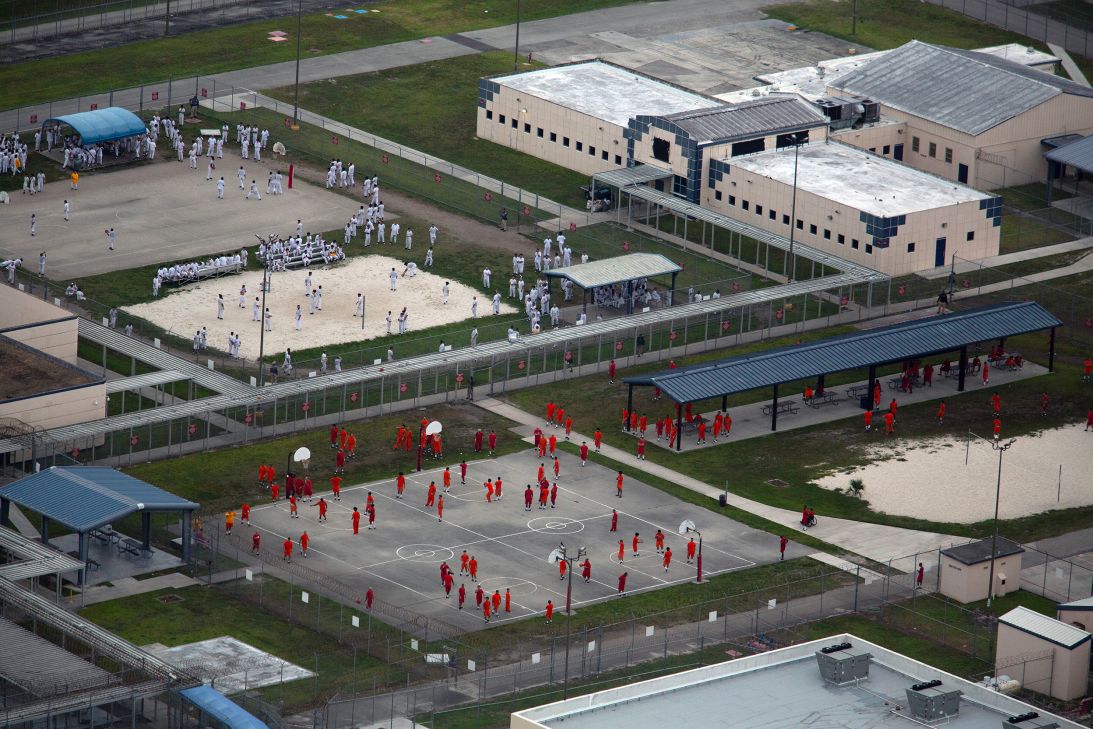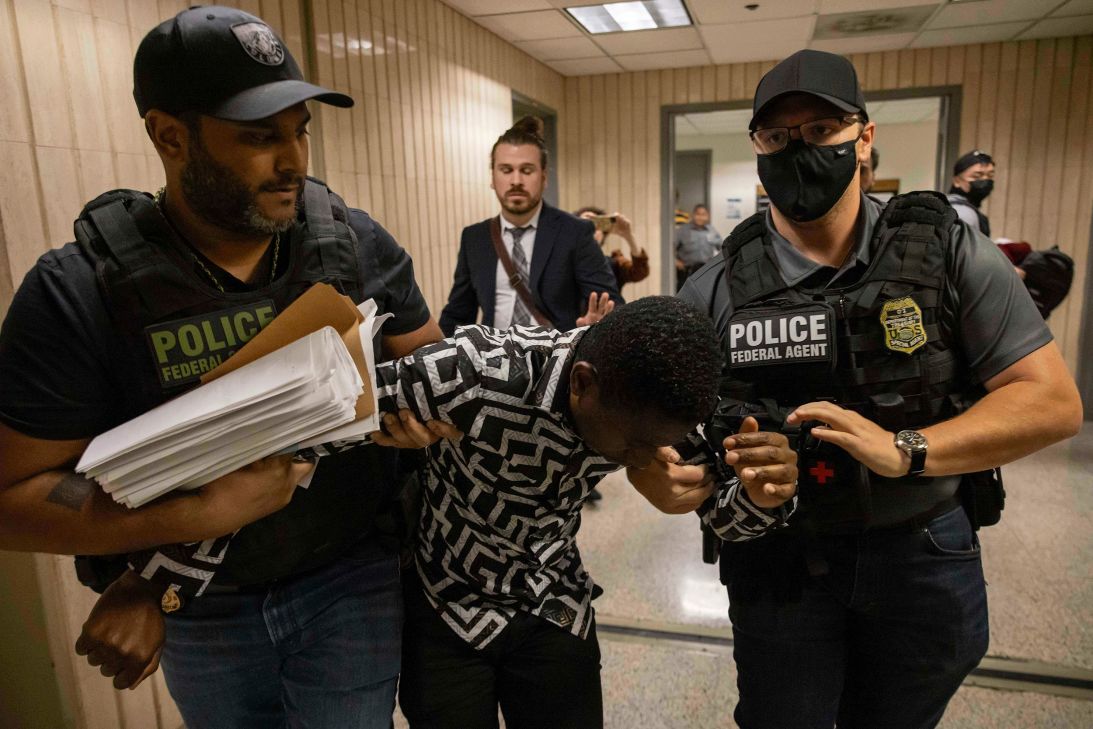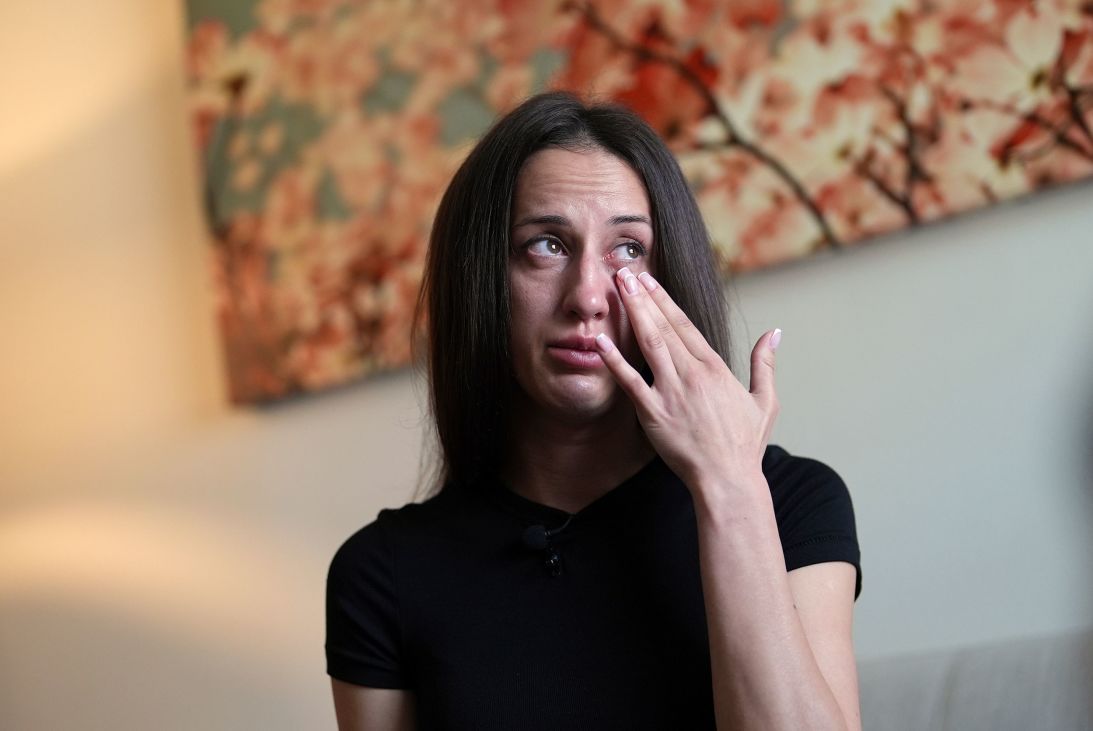Men sleeping head-to-toe on a crowded floor, exhausted detainees blocking out fluorescent lights with face masks, and dozens of people using cardboard boxes as mattresses.
Grainy cellphone video, filmed by a detainee in Immigration and Customs Enforcement custody in recent months, offers a rare public view of the harsh conditions inside a hold room in Miami – a temporary space where immigrants wait to be transferred to longer-term housing or deported.
ICE’s policies for decades have required the agency to keep migrants in cramped hold rooms like this for no longer than 12 hours.
Yet inside the Krome detention center in Miami, the average hold room stay has been more than three days. Some detainees say they have been left pleading for more food and water. One man who spent more than three days in a hold room later died in ICE custody. Even an internal ICE audit earlier this year found detainees were held for too long in the hold rooms and weren’t given pillows or blankets, and that staff didn’t follow procedure on providing meals.
“It was terrible,” said Mopvens Louisdor, an ICE detainee who has had two stints in a Krome hold room. “It’s hot, the AC was broken … they were sleeping on the cement floor, and … getting sick.”
Across the country, in fact, ICE has routinely broken its longstanding rules as it ratchets up President Donald Trump’s promised mass deportations, a CNN analysis of data from the agency found.
Over the first six months of Trump’s term, 18% of detainees placed into ICE hold rooms were kept there longer than 12 hours – up from only about 4% in 2024, the data shows. At several facilities, detainees have been kept in hold rooms for two or three days on average, with some detainees staying in the rooms a week or longer.
In late June, as evidence was piling up that the agency’s 12-hour policy was frequently being violated and lawmakers pushed for a fix, ICE instead modified its rules. The agency issued a memo allowing detainees to be kept in some hold rooms for a maximum of 72 hours excluding “exceptional circumstances,” court documents show, as a “result of increased enforcement efforts” under Trump.
That new 72-hour standard applies only to hold rooms inside ICE field offices, administrative spaces where immigrants have check-ins and interviews – but not in detention centers like Krome, which are built to keep large numbers of detainees in custody. Inside Krome, hold rooms are significantly less equipped for long stays than the main detention areas, which have beds, showers and other infrastructure. The average stay in Krome’s hold rooms is the longest of any ICE hold room during the second Trump administration.
Most of the data CNN reviewed covered detentions during the first five months of the Trump administration, before the rule change.

CNN spoke to current ICE detainees as well as attorneys who have visited ICE detention facilities, all of whom described overcrowded conditions and long stays in some hold rooms.
Katie Blankenship, an immigration attorney in Miami, said the Krome detention center has been so crowded over the last few months that she’s seen nine men jammed into attorney-client meeting rooms converted to makeshift holding cells, with just a cardboard box on the ground for bedding.
“It’s the most miserable situation you can imagine,” Blankenship said, describing long stays in Krome’s hold rooms as “perpetual purgatory without basic human necessities.”
In a statement, a spokesperson for the Department of Homeland Security said ICE operates hold rooms in “strict accordance” with its detention standards, and disputed that there are substandard conditions at any of its facilities.
“All detainees are provided with proper meals, medical treatment, showers, blankets, and have opportunities to communicate with their family members and attorneys,” the spokesperson said. “The truth is most ICE facilities have higher detention standards than most U.S. prisons that hold actual U.S. citizens. Ensuring the safety, security, and well-being of individuals in our custody is a top priority.”
‘Not hospitable places’
For tens of thousands of migrants swept up in the Trump administration’s dragnet – most of whom do not have a criminal record – hold rooms are one stop on the journey through a sprawling immigrant detention system.
ICE’s network includes more than 160 facilities classified as hold rooms, according to the agency data published by the Deportation Data Project, a research group associated with the University of California, Berkeley law school that obtained it through a Freedom of Information Act lawsuit.
Most hold rooms are located in ICE field offices around the country, while a handful are part of larger detention centers.
Since at least 2000 – before ICE was even a distinct government agency – there’s been a standard to limit detainees’ time in hold rooms to 12 hours. When ICE most recently revised its National Detention Standards in February 2025, the rule remained on the books.
Dora B. Schriro, the founding director of the ICE Office of Detention Policy and Planning during the Obama administration, said the rule was an important protection for detainees.
“These are not hospitable places,” Schriro said.
But those time limits were exceeded after Trump took office in January, the data shows, as the new administration swiftly stepped up detentions of immigrants around the country, and issued orders limiting releases, leading to a surge in detention center populations.
Conditions in hold rooms, and how long people are kept there, vary widely around the country. At some smaller facilities, hold rooms are only built to hold a handful of people at a time, and detainees are regularly moved through them within an hour or two, the agency’s data shows.
But in other centers, detainees spend hours or days on average in hold rooms as they wait for ICE agents to move them to longer-term living quarters, transfer them to other facilities or deport them.
At Krome, 62% of detentions in hold rooms have lasted longer than the 12-hour maximum during the Trump administration.
According to a ICE compliance inspection report from April, the facility received a waiver allowing it to stop recording hold room placements in mid-February, and the data shows a steep drop in hold room stays at the same time, so the more recent data is likely incomplete. But the overall Krome population spiked in June, and detainees, lawyers and advocates familiar with the center say that the overcrowding depicted in the data continues to be a major concern.
Meanwhile, at hold rooms in a Baltimore federal building – which had received an exemption allowing holds up to 60 hours in February – 92% of detentions have been longer than 12 hours. The average stay is 53 hours at the hold rooms in Baltimore, and 32 hours at hold rooms in a federal building in New York City.

Of the 267 detention facilities that have been used both in 2024 and during Trump’s term and have had at least 10 people in them at some point, 81% have reached a higher occupancy since Trump took office than they ever had in 2024, according to the data. Roughly half reached new peak occupancies either in June or July.
More than 600 people were kept in Krome hold rooms simultaneously in mid-February. ICE’s New York office had 191 people in hold rooms in early July, while the Baltimore hold rooms reached a maximum of 114 people in mid-June.
With the Trump administration ignoring the agency’s longstanding practice on hold rooms, “it’s highly likely you’re going to have an increase in deaths in detention and serious medical conditions,” Schriro said.
Cellphone videos taken inside hold rooms at the Krome detention center and a New York City federal building show alarming conditions.
A Manhattan video, which was released to journalists by an immigrant rights group in July, showed about two dozen men packed into a room appearing to have nothing to sleep on but thermal emergency blankets.
A class action lawsuit filed last month claimed that people were detained there “often for a week or more … without medication, an opportunity to bathe, brush their teeth or change their clothes,” and described conditions that were “crowded, squalid and punitive.” A federal judge ordered ICE to improve conditions at Manhattan hold rooms last month by reducing the number of detainees and making sure they have sleeping mats and could contact their attorneys.
Other videos from Krome, which were posted on social media, show men sleeping on the floor and curled up in chairs without blankets. A man recording one video asks for help in Spanish, saying detainees need more food and water.
The DHS spokesperson said the Trump administration is increasing detention space, noting that the budget bill passed by Congress and signed by the president this summer will allow the agency to “maintain an average daily population of 100,000 illegal aliens and 80,000 new ICE beds.”
‘Overwhelming, overcrowded’
Immigrant advocates say the conditions are particularly bad at Krome, a former Cold War missile base on the edge of Miami’s urban sprawl, which was converted into an immigrant detention center in the 1980s.
Among those detained at Krome earlier this year was Maksym Chernyak, a 44-year-old Ukrainian man who died while in custody.
Chernyak, who came to the US last August, was arrested in January and charged with battery with bodily harm over what his common-law wife Oksana Tarasiuk told CNN was a misunderstanding exacerbated by a language barrier with police officers. The ICE data shows that Chernyak was detained by ICE immediately after his release from jail, and spent more than three and a half days in a Krome hold room before being moved to the main detention center.

Chernyak told Tarasiuk he was one of about 30 people packed into a hold room, and that he had to sleep on the concrete floor in the cold and didn’t have an opportunity to shower, she said. She said he started feeling sick while he was in the hold room.
Chernyak repeatedly requested medical attention, according to Tarasiuk and the family’s lawyers, who said he was “largely ignored.” Nurses at the facility examined Chernyak twice over the next week and recorded that his blood pressure was rising but took no action to address it, the family’s attorney said.
Then, early in the morning of February 18, Chernyak began having seizures and vomiting in his bunk bed. His “bunkmates immediately called for help but witnesses report that neither guards nor medical staff appeared for twenty to thirty minutes,” his lawyers wrote in an administrative complaint against ICE.
Chernyak was unresponsive when medical staff arrived at around 2:32 a.m., according to ICE medical records obtained by his lawyers. But the staff initially believed he was “intoxicated,” and didn’t call for emergency help for about 45 minutes, until he had another round of seizures in a medical bay, the records show.
By the time Chernyak was admitted to a Miami hospital, he was completely unresponsive, and he was pronounced dead two days later. Chernyak’s toxicology reports later showed he hadn’t been intoxicated, according to his family’s attorney.
Blankenship, the Florida lawyer who is representing Chernyak’s family in a claim against ICE, said she thought the facility’s overcrowding led to him getting delayed medical attention for his high blood pressure.
“This is something that is treatable, it’s not something that has to kill you,” Blankenship said. “There’s no question that Maksym would be alive today if he hadn’t found himself in ICE custody.”
The DHS spokesperson disputed that Chernyak’s death was linked to improper medical care or overcrowding at Krome, and said nurses “rushed to assist” Chernyak when they learned of his medical emergency.
“All in-custody deaths are tragic, taken seriously, and are thoroughly investigated by law enforcement,” the spokesperson said.
Tarasiuk said it had been hard for her to go on without her husband. “Everyone tells us that time heals, but it doesn’t heal,” she said. “The joy of life is gone, gone.”

Chernyak is one of at least 12 people who have died in ICE custody so far this year — including three at Krome — up from seven over the first eight months of 2024, according to agency statistics.
The April compliance report noted numerous deficiencies in Krome’s hold rooms, including overcrowding and detainees kept past the 12-hour time limit. It found that all of the 57 detainees interviewed at Krome complained about excessive hold room times. The facility had no recording of whether staff had offered a meal to any detainee who’d been in a hold room for more than six hours, the inspection report noted.
Louisdor, the immigrant who has spent two stints in Krome’s hold room, told CNN in an interview from the detention center that it was difficult to get medical help in hold rooms.
Louisdor, who came to the US as a child from Haiti and was convicted of aggravated battery as a minor, said he spent several hours in a Krome hold room earlier this year, alongside other men who told him they had been kept in the room for days.
“The body odor is very bad. They weren’t allowing them to shower,” Louisdor said. “It was just overwhelming, overcrowded.”
Immigration attorney Amelia Dagen said conditions were similar at the Baltimore hold rooms.
“There’s no bedding, there’s no sheets, there are no blankets, except for the little foil aluminum blankets,” Dagen said. “Quantities of food were really small … access to water has been very limited.”
Some advocates said they thought the hostile conditions at ICE facilities have encouraged detainees not to fight efforts to deport them.
“They’re voluntarily taking deportation orders because they want to get out of the detention facility,” said Rachel Girod, another immigration attorney who has represented migrants detained by ICE.
CNN’s Nina Subkhanberdina contributed reporting.



